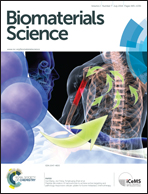Chalcone coating on cotton cloth – an approach to reduce attachment of live microbes†
Abstract
Drug resistant bacteria are a major threat to humans, especially those which mediate nosocomial infections. In this paper, three different 4-sulfonylmethyl chalcones are coated onto cotton cloths with acacia as the binder using a padding mangle to make them antibacterial. A 99% reduction in the adhesion of three slime producing organisms, namely Staphylococcus aureus NCIM5021, Escherichia coli NCIM2931 and Pseudomonas aeruginosa NCIM2901, on these surfaces was observed. The coated surfaces are more hydrophobic than the original one. The attachment of the bacteria (CFU ml−1) to the cloth is directly proportional (correlation coefficient, R = 0.58) to the hydrophobicity of the surface of the microorganism. The extent of bacterial attachment on the cloths (CFU ml−1) is not correlated with the minimum inhibitory concentration (MIC) of the chalcones (R = −0.1), but on the other hand it is negatively correlated with the hydrophilicity of the coated cloth (R = −0.52). This indicates that hydrophilic surfaces prevent bacterial attachment and hydrophobic organisms have a greater propensity to attach to hydrophobic surfaces than hydrophilic ones. A simple multi-linear regression model with the surface hydrophobicity of the organism and the hydrophilicity of the cloth is able to predict the extent of bacterial attachment. This study suggests that the coated cloths could find applications in hospital environments.


 Please wait while we load your content...
Please wait while we load your content...